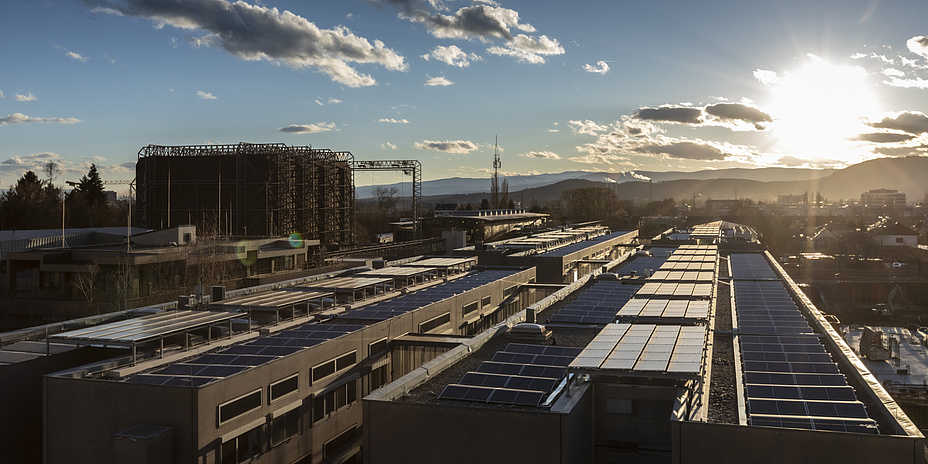The PV Potential in Austria is Huge

News + Stories: The Renewable Energy Expansion Act (EAG) provides for an additional 11 TWh of annual electricity generation from PV systems in Austria by 2030 compared to 2020. That would be a total of 13 TWh. Is this a realistic goal?
Sonja Wogrin: Absolutely! We are currently well on the way to achieving the objectives of the EAG. As of the end of July 2024, we have already installed around 7.5 GWp of photovoltaic capacity, which generates around 7.5 TWh per year. This corresponds to around 57% of the EAG target for 2030.
Apart from the EAG, how many TWh of PV electricity per year would be desirable or theoretically possible with current technology?
Sonja Wogrin: Austria’s electricity consumption will rise sharply by 2040 and may almost double. Depending on the electricity demand in 2030 and available demand-side flexibilities and storage capacity, the optimum for PV can vary. The potential in Austria is huge. Some studies assume a physical-theoretical potential of almost 60 TWh for buildings, landfills and transport areas alone, whereas the realistic potential of these areas is around 16 TWh. In addition, there are ground-mounted systems, although the land use must be considered here. Agri-PV offers a good compromise between energy generation and agricultural utilisation.
This interview is part of the dossier "Soak up the Sun", in which experts from different fields of research at TU Graz share their insights on solar energy.
We often read that PV systems cannot be connected due to bottlenecks in the grid. Can you expand on this issue?
Alexander Konrad: The Austrian electricity grid was essentially built after the Second World War based on the assumption that electricity is generated in large centralised power plants, transported via transmission lines to the individual regions and from there via distribution grids to the customers. All these grids were therefore generally designed for the maximum expected consumption in the respective grid area. The transformation from large centralised generators to small decentralised generators is now changing the direction of the electricity flow and the comparatively weak grids (e.g., local grids) are not only covering their own consumption, but also feeding energy back into the higher grid levels. However, the associated power already exceeds the limits for which the grid was designed in some places. In addition to the problem of line capacity (possible transmission power via a line), compliance with voltage limits is also a problem in many cases. The more power is transmitted via a line, the greater the losses associated with voltage drops. Compliance with these limits is crucial to ensuring that all generation units, as well as consumers, can be operated safely at all times.
How must the expansion of the grid be planned so that the problem does not become even greater with further PV expansion?
Sonja Wogrin: Grid expansion will be necessary in almost all regions and at all voltage levels, from large transmission lines to the local grids. The big question is how much these networks need to be strengthened. Of course, this also has an impact on the electricity bills of all customers, as the investments in grid expansion are refinanced via the grid fees. In the case of smaller systems, limiting the maximum feed-in to the grid, which only happens in a few hours a year, could also significantly reduce the need for grid expansion. The larger and, above all, the closer power plants are to substations, the less grid expansion is required.
With electricity from renewable sources in general and from PV in particular, there is always the question of how surpluses from high generation periods can be stored for phases of lower generation. What would be the right approach for you here?
Alexander Konrad: A broad mix will be necessary, especially for storage systems. Whether it’s about compensating for short-term fluctuations in generation and stabilizing the grid, or bridging hours and days with low renewable generation. Or even storing surpluses from the summer months for the winter. In addition to generation from PV and storage, the diversification of generation is also important. By increasing the expansion of wind power, which tends to generate more during the weaker PV halves of the year, the amount of storage energy required can be reduced. Energy system optimisation models can be used to determine the optimum mix of these storage systems.

Depending on the weather conditions, electricity production from wind power and photovoltaics fluctuates considerably, to which grid operators must react continually. How accurately can production from renewables currently be forecast and measured? Is technological progress needed in this area?
Alexander Konrad: The forecast for renewable energies depends very much on the weather forecast, which is of course difficult to predict in the long term but works better in the short term. However, climate change is making these predictions increasingly difficult. This makes it more important to integrate flexible elements such as storage systems into the system that can compensate for fluctuations.
The decarbonisation of the electricity system is one of the central points of your research. How well are we doing here and how much can solar energy contribute?
Sonja Wogrin: In our research, we focus on the (power) energy system as a whole, not just on decarbonisation. Solar energy is certainly an important part of this, but it needs a good mix with other technologies such as wind and hydropower as well as storage. The great advantage of PV is that practically anyone can become an energy producer by installing a PV system on their roof or balcony (balcony power plant) and thus contribute to the energy transition and decarbonisation. Austria is already very advanced in the electricity sector, which is mainly due to our privileged position in the utilisation of hydropower. Looking at the total energy demand, the share of renewable energies in 2023 is only just over 35%. Major efforts are still required to achieve complete decarbonisation of total energy demand (including industry, transport, heating, etc.).
The earth receives an enormous amount of solar energy every day, but we can only utilise a very small part of it, for example with PV or solar systems. What energy innovations can help us to utilise this energy even better?
Alexander Konrad: Complete decarbonisation is possible with available technology. However, there is still a need for innovation in the interaction of all the stakeholders and the associated flexibilization of consumption. Intelligent interaction could, for example, increase consumption at times of peak generation or curtail generation plants to avoid overloading the grids. However, the efficient and cost-effective storage of energy will also play a central role in the future.
It is already possible today to operate a system without drawing a single kWh from the grid
If I build a PV system on the roof of my house and purchase my own storage system, how much self-sufficiency can I achieve? Could I theoretically manage without an external supplier?
Sonja Wogrin: It is already possible today to operate a system without drawing a single kWh from the grid. However, this currently still requires very high investments, and economic viability is questionable. With a “normal” PV system and commercially available battery storage systems, however, self-sufficiency values of approx. 80% can already be achieved with a heat pump and electric car.
And how large could the share of solar energy in total electricity production be? Would a self-sufficient supply be theoretically possible with this alone?
Alexander Konrad: Self-sufficiency in the sense of complete independence cannot be achieved with solar energy alone, nor does it make sense for the electricity grid. The Austrian electricity grid is part of the European interconnected grid, which is a good thing and an important factor. The possible and sensible share of solar energy will largely depend on how well the energy can be utilised directly, stored, converted into other usable forms of energy (e.g. hydrogen, heat, etc.) or exported during hours when there is a lot of solar energy. However, exports will only be possible to a limited extent, as the sun is also shining in our neighbouring countries during these hours, and they also have to deal with their surpluses.
Kontakt
Sonja WOGRIN
Univ.-Prof. Dipl.-Ing. Dr. M.Sc.
TU Graz | Institute of Electricity Economics and Energy Innovation
Phone: +43 316 873 7900
wogrin@tugraz.at
Alexander KONRAD
Dipl.-Ing. BSc
TU Graz | Institute of Electricity Economics and Energy Innovation
Phone: +43 316 873 7907
alexander.konrad@tugraz.at




